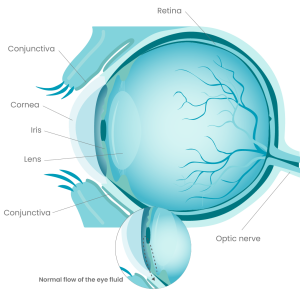Glaucoma is a very painful condition that often causes blindness. There are different types of glaucoma. Secondary glaucomas, constitute 95–98% of cases and are associated with disease or an injury to the eye.
Cats with glaucoma have high pressure inside the eye. Contact your vet immediately if your cat has symptoms of glaucoma or a painful eye. Glaucoma in cats appears more gradually and can be subtle compared to dogs.

Overview
What is glaucoma in cats?
- Fluid flows in and out of the eyes to keep them the right size, shape, pressure and to deliver nutrients.
- Glaucoma develops when something stops that fluid from flowing out, causing a build-up of pressure inside the eye (intraocular pressure).
- The increased pressure causes damage to the optic nerve, which normally sends vision messages from the eye to the brain.
- If treated early, blindness can be prevented or delayed but requires ongoing treatment. If identified too late, blindness may be permanent.
- There are two types of glaucoma in cats: primary and secondary.
Types of glaucoma
Secondary
The most common cause of glaucoma in cats.
It results from disease or an injury to the eye. Causes include:
- Uveitis (inflammation of the inside of the eye) or severe infections inside of the eye. These result in debris and scar tissue blocking the drainage.
- Bleeding inside of the eye. A blood clot can block drainage.
- Tumours. The mass can cause physical blockage.
- Diseases of the lens. Changes in the lens can physically block drainage.
Primary
Increased intraocular pressure in a healthy eye, due to an inherited abnormality in the drainage angle.
Symptoms
What are the clinical signs of glaucoma in cats?
- Cloudy or blue eye
- Red eye
- Squinting
- Sudden blindness
- Sleeping more
- Being head shy
- Tilting the head
Risk
Do some cats have a higher risk of glaucoma than others?
Breeds known to be affected by primary glaucoma are:
- Burmese
- Siamese
- Persian
Diagnosis
How is glaucoma diagnosed in cats?
Your vet will examine your cat’s eyes and use a light source.
If they identify any signs of glaucoma, they will confirm it using an instrument called a tonometer.
- A tonometer measures the pressure inside the eyes.
- Glaucoma will be suspected if there is a difference of 12 mmHg or more of pressure between the eyes, or more than 25 mmHg in older cats.
- It’s quite challenging to measure the eye pressure in cats.
Your cat may also need further tests to find the cause of the glaucoma, at which point they may need to visit an eye specialist.
Vet treatment
What is the treatment for glaucoma in cats?
Your vet will aim to bring down the pressure inside your cat’s eyes as quickly as possible.
Glaucoma can be treated with eyedrops, laser treatments, or surgery. The best treatment will depend on a variety of factors.
- Medical: anti-glaucoma eye drops. This includes painkillers and medication to reduce the pressure in the eye.
- Surgical: shunt placement or laser surgery. This type of surgery is usually performed by an eye specialist.
- If treatment is delayed or fails, the eye can become permanently blind and painful. Surgical removal of the eye, called enucleation, may be recommended in such cases.
Can glaucoma in cats be cured?
Unless the glaucoma has developed due to another cause, it cannot be cured and requires long-term management.
Secondary glaucoma:
- The outlook will depend on what’s causing the glaucoma and how well your cat responds to the treatment.
Primary glaucoma:
- Cats are likely to respond well to medication at the start. However, they may stop responding. In this case, surgical treatment will need to be considered.
If detected early enough and well controlled, cats can live with glaucoma without any pain.
In many cats, however, the disease will only manifest when it is already advanced, resulting in pain, vision loss, and, in some cases, eye removal.
It’s important to discuss the long-term outcome and treatment costs with your vet.
Home treatment
What to do at home if your cat becomes blind
Cats that lose their vision gradually can adapt well with the correct care.
Unfortunately, sudden blindness can happen.
There are many things you can do to help your cat if they have reduced vision or have gone blind:
- Avoid moving furniture or any of your cat’s belongings, such as their food dish, water bowl or bed.
- It’s important to pay special attention to hazards such as stairs, pools, and on the street. You may decide to keep your cat indoors all the time.
- Whenever your cat meets a new human or animal, they should be handled with extra care.
- Avoid any sudden and loud noises that may scare them.
- Place textured mats at the room entrances. Your cat will be able to differentiate the room they are in by the texture on their paws.
- Play is very important. Use toys that make a noise. This will help build their confidence and provide mental stimulation.
Prevention
What can you do to prevent glaucoma in cats?
Glaucoma is a complex disease that cannot be prevented by a single factor.
Breeders can reduce the risk of producing affected kittens by testing them (such as gonioscopy testing).
When to worry
When do you need to call a vet if your cat has glaucoma?
If your cat shows any of the following signs call your vet:
- Sudden inability to see
- Squinting
- Swollen eye
- Redness of the eye
- Reluctant to open the affected eye or pawing at the face
Call us at Joii if:
- You have a blind cat and need help adjusting to their environment
- If you need help applying or giving medication








